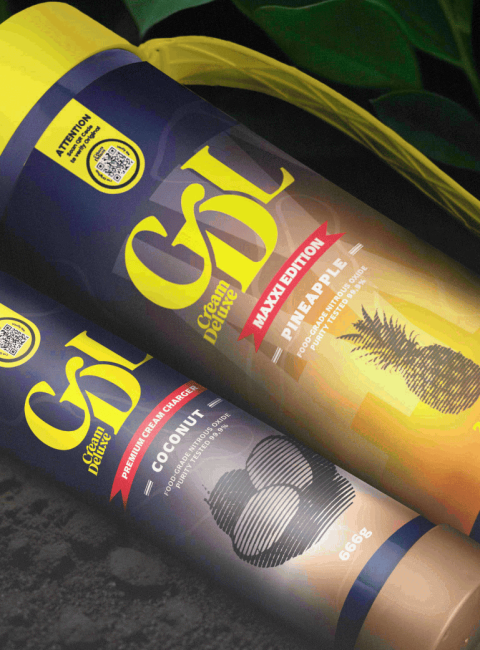powered by PiQR.io
powered by PiQR.io


When we talk about nitrous oxide (N₂O), commonly known as “laughing gas”, people often think of its use in hospitals for pain relief, or in some cases, its illegal recreational misuse. However, this gas also shines in the culinary world. To enter the kitchen though, it must “change its outfit” — and that brings us to today’s main focus: the food-grade nitrous oxide tank.
Food-grade nitrous oxide and medical-grade nitrous oxide are not interchangeable. Medical N₂O emphasizes pharmaceutical-level sterility and physiological safety, while food-grade N₂O focuses more on compatibility with food ingredients, food-contact safety, and flavor purity. The two differ significantly in purity control, regulatory systems, and packaging design.
This article will take you through the key features of food-grade nitrous oxide tanks, their differences from medical ones, and the diverse ways they are used in culinary applications.
Purity and Impurity Control
Medical-grade N₂O has extremely high purity (typically ≥99.999%), is produced in sterile environments, and undergoes rigorous safety testing for pharmaceutical use. Impurity control is particularly strict.

Food-grade N₂O also has high purity (≥99.9%) but focuses more on compatibility with food components, preventing undesirable chemical reactions with fats like cream.
Manufacturing and Processing Standards
Medical-grade nitrous oxide is produced following pharmaceutical standards, and its packaging containers must meet medical safety specifications.
Food-grade nitrous oxide is produced in accordance with food safety standards (such as EU E942 certification), commonly found in single-use small cream chargers, like Cream Deluxe nitrous oxide cartridges, which are designed for kitchens and dessert applications — safe and efficient.
Regulatory System Differences
•Medical gases are regulated by national pharmaceutical agencies such as the FDA and EMA.
•Food-grade gases are managed under food additive systems and must comply with relevant food hygiene regulations.
Container Structure and User Experience
•Medical gas cylinders are usually large and require complex equipment.
•Food-grade cream chargers are designed for single-use, easy to operate, tightly sealed, and compatible with most commercial whipped cream dispensers — making them ideal for both home and professional kitchens.
In the culinary world, food-grade nitrous oxide is known as “liquid sunshine in the kitchen.” It not only enhances the texture and appearance of food but also inspires culinary creativity. Do you know all the powerful ways it can be used? Let’s explore them together!
Whipped Cream and Mousse Making

Using Cream Deluxe cream chargers, simply add fresh cream into a dispenser, charge it, and within seconds you’ll have whipped cream. The texture is light, the foam is uniform, and the mouthfeel is smooth — perfect for cake decoration, mousse layers, or ice cream bases.
Foams in Molecular Cuisine
By adding purees, spice-infused liquids, or sauces to a cream dispenser and charging it with food-grade N₂O, you can create stable flavor foams. For example:
•Basil foam served with tomato salad
•Mango mousse foam for dessert garnishing
•Black garlic foam sauce to enhance meat dishes
These are visual and sensory highlights in modern molecular cuisine.
Molecular Cocktails and Foam for Mixology

Bartenders use cream chargers to add aromatic foams to cocktails, such as lemon, lavender, or vanilla foams. These enhance the aroma, appearance, and layering of drinks, making them a staple tool in modern bars and upscale restaurants.
Rapid Marination and Flavor Infusion

N₂O gas can create a high-pressure environment that enables vacuum flavor infusion, allowing marinades to quickly penetrate meats, fruits, or vegetables. A process that used to take hours can now be completed in minutes, improving efficiency and flavor consistency.
Using pressurized gas in food preparation must follow specific safety guidelines, or it may cause equipment failure or health risks. Below are a series of practical tips for using Cream Deluxe cream tanks:
Proper Storage
Store cream chargers in a cool, dry, and well-ventilated area. Avoid high temperatures (not exceeding 50°C) and open flames. Keep out of reach of children and unauthorized personnel.
Choose Certified Food-Grade Products
Do not use N₂O gas of unknown origin or non-food grade. Make sure the product is clearly labeled as food-grade, certified (e.g. E942), and has passed safety checks with no harmful residues.
Use Professional Dispensing Equipment
Only use certified whipped cream dispensers. Do not manually puncture chargers or use modified devices. Regularly inspect gaskets, nozzles, and components of the dispenser to ensure they’re intact.
Control the Charging Dose
A single Cream Deluxe charger (8g) can be used to whip 500ml of cream. Before recharging, ensure all pressure has been fully released to avoid overpressurization hazards.
Keep Equipment Clean
After each use, disassemble and clean all parts of the dispenser — including nozzle, valve, and container — to prevent cream residue from going bad or breeding bacteria.
Use Responsibly, Avoid Misuse
Nitrous oxide is intended strictly for food processing use. Misuse can pose serious health risks. Cream Deluxe consistently advocates for safe and professional use of its products.
Food-grade nitrous oxide tanks are not just kitchen tools — they are gateways to culinary innovation. From whipped cream and molecular foams to rapid marination and aromatic infusion, they play a key role in every creative dish.
Choosing Cream Deluxe cream tanks means choosing a food-grade N₂O solution with high purity, top-level safety, and exceptional performance. They bring you improved texture, higher output efficiency, and endless inspiration.
That next dessert to wow your guests? It might just begin with a single Cream Deluxe cartridge in your hand.
| Cookie | Duration | Description |
|---|---|---|
| cookielawinfo-checkbox-analytics | 11 months | This cookie is set by GDPR Cookie Consent plugin. The cookie is used to store the user consent for the cookies in the category "Analytics". |
| cookielawinfo-checkbox-functional | 11 months | The cookie is set by GDPR cookie consent to record the user consent for the cookies in the category "Functional". |
| cookielawinfo-checkbox-necessary | 11 months | This cookie is set by GDPR Cookie Consent plugin. The cookies is used to store the user consent for the cookies in the category "Necessary". |
| cookielawinfo-checkbox-others | 11 months | This cookie is set by GDPR Cookie Consent plugin. The cookie is used to store the user consent for the cookies in the category "Other. |
| cookielawinfo-checkbox-others | 11 months | This cookie is set by GDPR Cookie Consent plugin. The cookie is used to store the user consent for the cookies in the category "Other. |
| cookielawinfo-checkbox-performance | 11 months | This cookie is set by GDPR Cookie Consent plugin. The cookie is used to store the user consent for the cookies in the category "Performance". |
| viewed_cookie_policy | 11 months | The cookie is set by the GDPR Cookie Consent plugin and is used to store whether or not user has consented to the use of cookies. It does not store any personal data. |